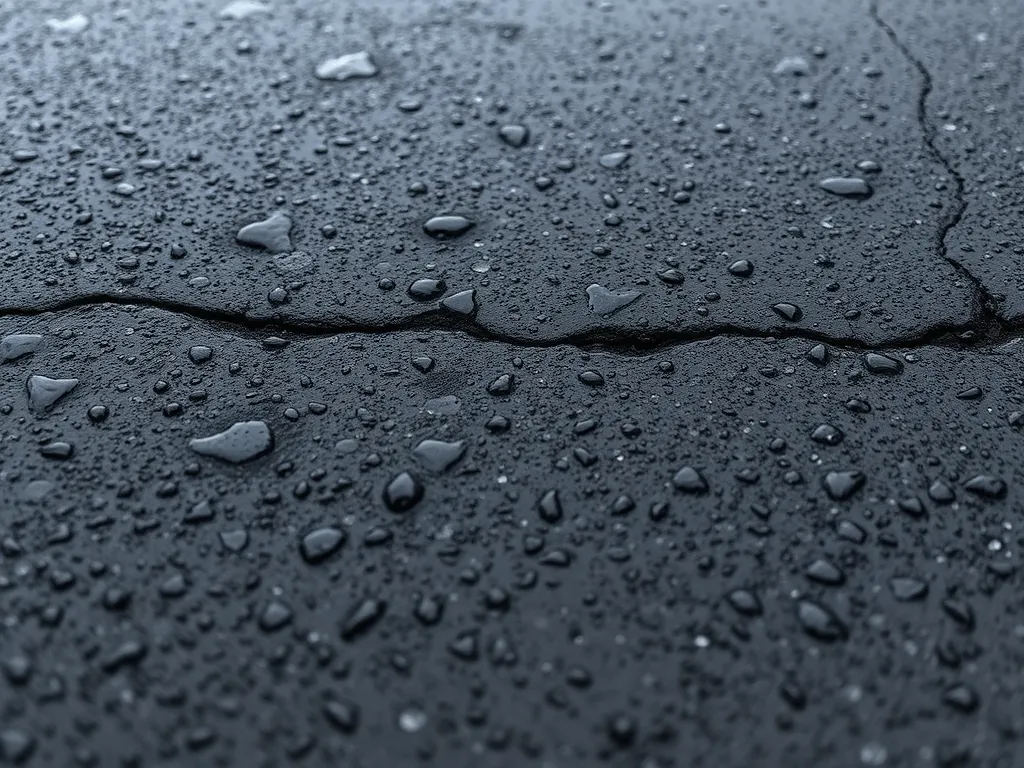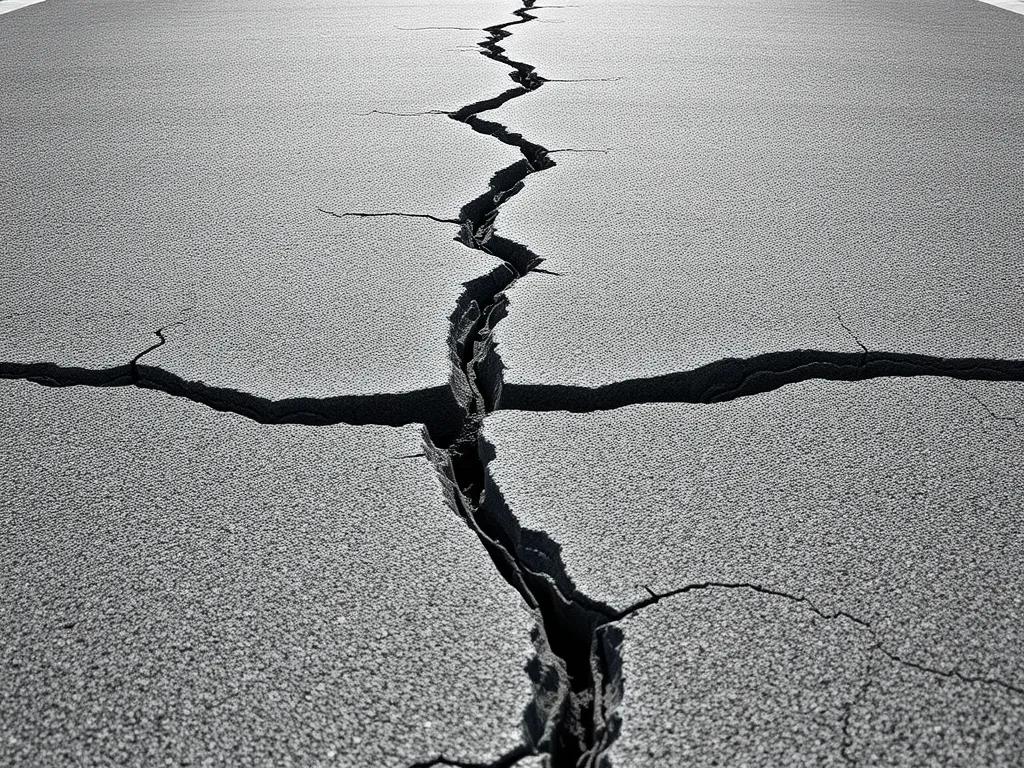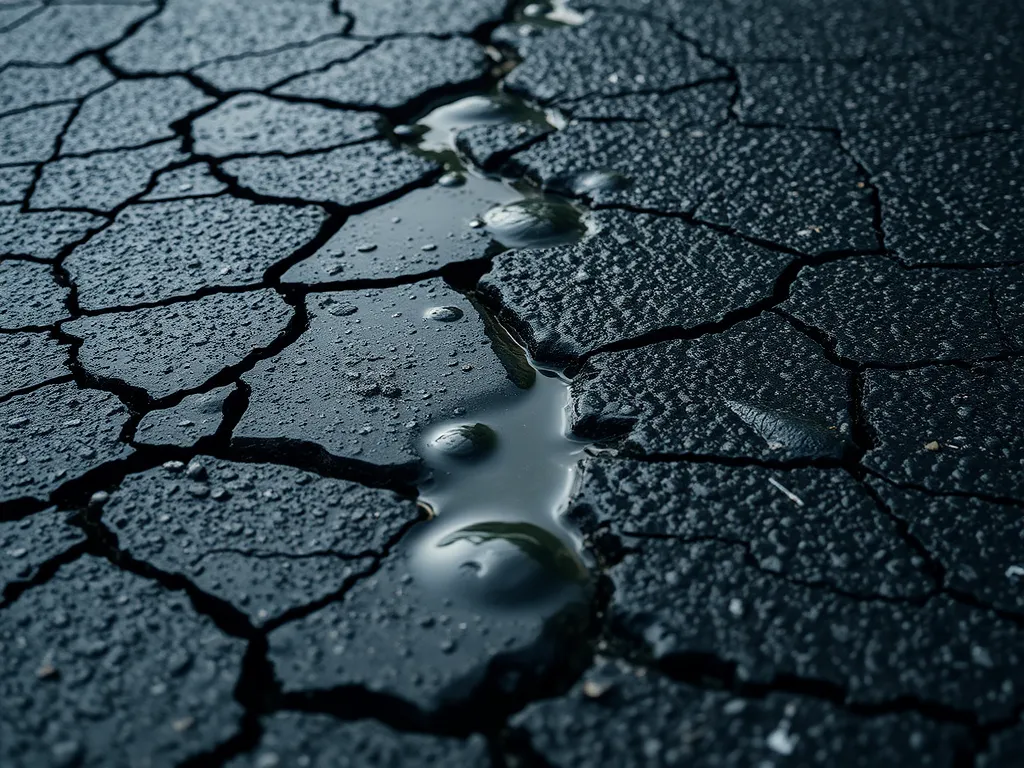Does Asphalt Absorb Water? Key Properties & Implications
Published on: November 18, 2025 | Last Updated: April 14, 2025
Written By: George Voss
Asphalt absorbs minimal water due to its low porosity. Typical asphalt mixes hold 4-5% water by volume, with most moisture draining through surface pores rather than being retained. The material’s composition—aggregates like crushed stone bonded with bitumen (asphalt’s sticky binder)—creates a semi-permeable surface. Cracks, aging, and poor compaction increase absorption over time.
This article examines how asphalt interacts with water across seasons, compares its absorbency to concrete, and analyzes drainage capabilities. Learn about industry-standard absorption tests, maintenance strategies like sealcoating, and solutions to prevent water damage in driveways and roads.
Contents
- Does Asphalt Absorb Water?
- How Absorbent is Asphalt Compared to Other Materials?
- Does Blacktop Absorb Water?
- Seasonal Impact: Does Asphalt Absorb Water in the Summertime?
- Is Asphalt Good for Drainage?
- Implications Of Water Absorption on Asphalt Longevity
- Testing Asphalt’s Water Absorption
- Mitigating Water Absorption in Asphalt
- FAQs: Addressing Common Concerns
- Closing Thoughts
- Useful References for You:
Does Asphalt Absorb Water?
Asphalt isn’t fully waterproof but can hold small amounts of liquid. Its capacity to soak up rain or snowmelt impacts durability, surfacе quality, and drainagе. Let’s analyzе how this matеrial intеracts with H2O.
Understanding Asphalt’s Water Interaction
Thе mix of stonе, sand, and bitumеn (a sticky pеtrolеum byproduct) forms a semi-pеrmеablе structurе. Tiny gaps bеtwееn aggrеgatеs allow minimal moisturе intrusion. This trait affеcts pеrformancе in various wеathеr conditions.
Porosity and Composition of Asphalt
Typical asphalt contains 3-5% air voids duе to its aggrеgatе gradation and compaction during installation. PG (Pеrformancе Gradеd) bindеrs—likе PG 64-22—hеlp rеducе voids in hot mix asphalt. Supеrpavе dеsigns optimizе void ratios for local climatеs. Cracks or poor compaction can push porosity to 7%, raising absorption risks.
How Much Water Can Asphalt Hold?
On avеragе, 1 squarе yard of asphalt with 4% voids holds up to 0.5 gallons. Crackеd pavеmеnts may absorb 70% morе—roughly 0.85 gallons. Comparе this to concrеtе, which typically holds 1-2% by volumе. Sеalcoating cuts absorption by 50-80%, but aging rеvеrsеs this gain.
How doеs this comparе to matеrials likе concrеtе or blacktop? Thе nеxt sеction brеaks down absorption ratеs and long-tеrm implications.
How Absorbent is Asphalt Compared to Other Materials?
Asphalt’s ability to take in water depends on its mix and how it’s built. Let’s see how it stacks up against common surfaces and what makes it let water in.
Asphalt Vs. Concrete in Water Absorption
Asphalt holds 4-5% air voids, while concrete has 8-12% pores. But asphalt’s voids link up, letting water flow through gaps. Concrete traps water in hidden pockets. This makes asphalt dry faster but crack more in cold snaps. See the key differences:
| Material | Air Voids (%) | Water Flow Rate | Freeze-Thaw Risk |
|---|---|---|---|
| Asphalt | 4-5 | 0.1-1.0 in/hr | Cracks form |
| Concrete | 8-12 | Traps water | Surface spalls |
Factors Affecting Absorption: Pores, Cracks, and Aging
New asphalt resists water due to dense layers. Over time, sun and wear break down the bitumen binder. Cracks let water seep in 3x faster. Heavy traffic speeds this up. A 10-year-old lot can soak 8% more water than new builds.
Sealcoating fills small gaps, cutting water take by 70% for 2-3 years. But deep cracks need patching first. Polymer mixes (like PG 76-22) boost grip and block moisture, costing 15-20% more than standard blends.
While material choice and age shape water intake, color also plays a role. Dark hues trap heat, which changes how asphalt deals with rain and dew…

Does Blacktop Absorb Water?
Blacktop—a common term for asphalt used in driveways and parking lots—shares similar materials with traditional asphalt but differs in mix ratios and construction. Both contain aggregates (crushed stone, sand) bound by bitumen, but blacktop typically has a higher stone concentration (up to 80%) and smaller bitumen amounts (6-8%). This affects how it interacts with water.
Differences Between Traditional Asphalt and Blacktop
Traditional asphalt prioritizes flexibility for high-traffic roads, using 5-7% bitumen with mid-sized aggregates. Blacktop’s denser stone matrix (larger, angular aggregates) creates tighter compaction, reducing initial porosity to 3-5% compared to standard asphalt’s 5-7%. While less porous, aging blacktop may still allow water ingress through micro-cracks formed during installation or temperature shifts.
Impact Of Color on Heat and Moisture Retention
Blacktop’s dark color absorbs up to 90% of solar radiation, raising surface temps by 40-50°F versus lighter materials. This heat softens bitumen, expanding the pavement. Nighttime cooling triggers contraction, gradually forming cracks. Water then penetrates these fissures, accelerating wear. Though less absorbent than concrete, black asphalt retains moisture longer in cracks, increasing freeze-thaw damage risks in cold climates.
Up next: How summer heat amplifies water-related stress on asphalt surfaces.
Also See: Common Asphalt Maintenance Mistakes
Seasonal Impact: Does Asphalt Absorb Water in the Summertime?
Asphalt’s interaction with water shifts dramatically with temperature changes. Summer heat and winter freezes create unique challenges affecting how much moisture pavement absorbs or retains.
Heat Expansion and Water Penetration
At 85°F+, asphalt surfaces soften due to thermal expansion. This weakens the binder-bitumen bond, widening existing cracks by up to 2-3mm. Rainwater seeps into these micro-fissures, with black asphalt absorbing 15-20% more solar radiation than lighter surfaces. Over 7-10 days of sustained heat, trapped moisture can erode the sub-base, accelerating rutting and pothole formation. Polymer-modified mixes reduce summer water intake by 30-40% compared to standard asphalt.
Winter Risks: Freeze-thaw Cycles and Cracking
Water absorbed during summer becomes destructive below 32°F. A single freeze-thaw cycle expands moisture volume by 9%, generating 300-500 psi pressure inside pavement pores. After 5-7 cycles, hairline cracks grow into fractures spanning 50-80% of the surface. Road salt worsens damage by lowering water’s freezing point, prolonging expansion phases. Properly graded slopes and 4-6% air voids in asphalt mixes help mitigate this.
Seasonal shifts highlight why drainage design directly impacts pavement survival. Next, we’ll break down engineered systems that channel water away from vulnerable layers.

Is Asphalt Good for Drainage?
Asphalt does not absorb water like sponge materials, but its drainage performance depends on design. Properly engineered asphalt surfaces channel water efficiently, preventing pooling. Without strategic planning, water can seep into cracks or sit on the surface, accelerating wear.
Designing Effective Asphalt Drainage Systems
Drainage systems in asphalt focus on moving water away from the surface. Key elements include slope gradients, surface textures, and sub-base layers. These components work together to minimize water contact, reducing risks linked to absorption or retention.
Slope and Surface Texture Considerations
A 2% minimum slope directs water toward drains or edges. Steeper slopes (up to 5%) improve runoff in high-rainfall areas. Surface texture matters too: coarse mixes with larger aggregates create tiny channels for faster drainage. Open-graded friction course (OGFC) asphalt, with 15-20% air voids, lets water flow through the surface layer into drainage pipes below.
Role of Sub-Base Layers in Water Management
Crushed stone sub-bases (6-12 inches thick) act as reservoirs for excess water. These layers, paired with geotextile fabrics, prevent soil contamination and allow gradual water dispersal. A well-built sub-base stops moisture from rising into asphalt layers, which helps avoid softening or structural failures caused by retained water.
Strategic drainage design keeps asphalt dry longer, but even minor flaws let water penetrate. Next, we’ll explore how absorbed moisture impacts pavement lifespan.
Implications Of Water Absorption on Asphalt Longevity
Asphalt soaks up water less than some materials. But when it does, the harm adds up fast. Even small amounts of trapped moisture speed up wear and tear.
How Water Weakens Asphalt Structure
Water slips into tiny pores or cracks in the asphalt. Once inside, it softens the binder (the “glue” that holds the mix). This weakens the bond between rock bits. Over time, the base layer below may wash out, causing dips. Heat and cold cycles make it worse—swelling when wet, shrinking when dry.
Link Between Moisture and Potholes/cracking
Potholes start with small cracks. Water fills these gaps, then freezes and grows. Ice pushes the asphalt up. When it melts, voids form. Cars drive over these weak spots, breaking the surface. Each rain adds more water, speeding the cycle. Unsealed asphalt holds 5-10% water by weight, making cracks spread 30% faster.
Testing how much water asphalt holds spots risks before they grow. Up next: how pros measure water soak levels.

Testing Asphalt’s Water Absorption
Accurate testing determines whether asphalt absorbs water and how much moisture penetrates its structure. Contractors use standardized methods to measure absorption rates and predict pavement performance.
Common Methods: Water Core Test and Thin Film Analysis
The water core test extracts cylindrical samples from paved surfaces. These cores undergo 24-hour submersion to measure weight gain. A 5% increase indicates moderate absorption, while rates above 7% signal vulnerability to moisture damage.
Thin film analysis evaluates asphalt binder performance. Lab technicians coat aggregates with a 15-micron asphalt film and expose it to water vapor. This reveals how quickly water penetrates the binder layer – a critical factor in determining if asphalt soaks up water under real-world conditions.
Industry Standards for Acceptable Absorption Levels
AASHTO T 166 and ASTM D1188 set maximum absorption thresholds:
- Hot mix asphalt (HMA): 1-3% by weight
- Porous asphalt: 16-20% for drainage systems
- Sealcoated surfaces: Below 0.5% when properly treated
Asphalt exceeding these levels risks premature raveling or potholes. Modified mixes with rubber or polymers often show 40% lower absorption than conventional asphalt, proving effective for high-moisture environments.
These test results directly inform maintenance plans and material selection. Next, we explore practical strategies to reduce asphalt’s water intake – from sealants to advanced polymer blends.
Mitigating Water Absorption in Asphalt
Reducing water absorption extends pavement life and prevents structural damage. Two proven strategies dominate: protective coatings and advanced mix designs.
Sealcoating: Does It Prevent Water Penetration?
Sealcoating creates a temporary shield against moisture. Applied every 2-4 years using coal tar or asphalt-based emulsions, it fills surface voids up to 0.5mm wide. While not fully waterproof, quality sealants reduce water absorption by 60-80% based on ASTM D7064/D7064M standards.
- Cost: $0.14-$0.25 per square foot for professional application
- Limitation: Won’t seal cracks wider than 1/8 inch
- Key test: Spray water on sealed asphalt – proper application causes beading
Using Modified Asphalt Mixes for Better Water Resistance
Advanced asphalt formulas combat permeability at the material level. PG (Performance Graded) binders and Superpave mixes – developed through the 1993-1998 Strategic Highway Research Program – now dominate commercial projects.
Polymer-Modified Asphalt Benefits
Adding polymers like SBS (styrene-butadiene-styrene) or crumb rubber transforms asphalt’s water resistance:
- Permeability drops to 0.5-2% versus standard mixes’ 1-5%
- Binder elasticity improves 300%, reducing crack formation
- Cost premium: 15-30% higher upfront, but doubles pavement lifespan
Field trials show polymer-modified asphalt retains 40% less moisture after storms compared to conventional mixes. The enhanced aggregate-binder adhesion leaves fewer entry points for water molecules.
With these solutions in place, property owners often ask practical questions about absorption rates and long-term impacts – topics we’ll explore next.

FAQs: Addressing Common Concerns
How Quickly Does Asphalt Absorb Rainwater?
Asphalt can begin to absorb rainwater almost immediately after precipitation starts. However, the actual absorption rate depends on factors like surface texture, existing cracks, and the asphalt mix used. Typically, any absorption occurs within a few minutes during a heavy rain, but moisture may take longer to permeate deeply, especially if the asphalt is well-constructed and sealed.
Can a Sealed Driveway Still Retain Moisture?
Yes, a sealed driveway can still retain some moisture, but the amount is significantly less compared to unsealed asphalt. Sealcoating helps fill in surface voids, preventing water infiltration to a degree, but it cannot make asphalt fully waterproof. If a driveway develops cracks or if the sealant wears off, moisture retention can increase.
Does Aging Increase Asphalt’s Water Absorption?
Yes, aging does increase asphalt’s water absorption capacities. As asphalt ages, the bitumen binder can break down due to UV exposure and wear, leading to increased porosity and the formation of cracks. This deterioration allows more water to penetrate, exacerbating structural issues and leading to further damage over time.
Closing Thoughts
Asphalt plays a critical role in various construction projects, particularly concerning water absorption. While it is not highly absorbent, factors like porosity, age, and environmental conditions can impact its behavior. Understanding these elements helps in making informed decisions about asphalt installation and maintenance.
Implementing effective drainage systems and considering modified asphalt mixes can greatly enhance durability. Regular maintenance and the application of sealcoating can further mitigate water penetration, ensuring long-lasting surfaces.
For more insightful information about asphalt and its properties, check out Asphalt Calculator USA.
Useful References for You:
- Huang, Y. H. (2004). Pavement Analysis and Design (2nd ed.). Upper Saddle River, NJ: Pearson/Prentice Hall.
- Permeable pavement is a kind of asphalt that absorbs water. #concrete #asphalt #science | TikTok
- Porous Asphalt and Concrete Pose Big Problems – TRUEGRID Pavers
- Water Absorbing Pavement: Find Out the Best Solution
- Why does water not penetrate through asphalt but easily goes through cement/concrete walls/floors, etc.? – Quora


